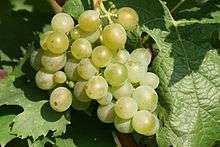Muscat bleu
Muscat bleu is a red Swiss wine and table grape variety that is a hybrid of Garnier 15-6 and Perle noire. The grape was developed in Peissy in the Canton of Geneva by Swiss grape breeder Charles Garnier in the 1930s. Today the grape is used as both a table grape and for winemaking, producing wines that Master of Wine Jancis Robinson describe as "soft and grapey". Outside Switzerland some plantings of Muscat bleu can also be found in Belgium.[1]
| Muscat bleu | |
|---|---|
| Grape (Vitis) | |
Muscat bleu. The colour changes to blue-black when ripe. | |
| Color of berry skin | Noir |
| Origin | Peissy |
| Original pedigree | Garnier 15-6 × Perle noire |
| Breeder | Charles Garnier |
Pedigree

Muscat bleu is considered to be a "complex hybrid", meaning that within its lineage are grape varieties belonging to several different species of the grapevine genus, Vitis. Despite having the name Muscat, there are actually no Muscat grape varieties closely related to Muscat bleu. The grape is result of a crossing of Garnier 15-6 and Perle noire, both varieties themselves being inter-specific crossings with complex lineages.[1]
Garnier 15-6 is a crossing of Villard noir, developed in Southwest France by Bertille Seyve and Victor Villard, and the Vitis vinifera grape Müller-Thurgau developed by Swiss grape breeder Hermann Müller. Villard noir is a crossing of the Seibel grapes Chancellor and Les Subéreux which have Vitis labrusca and Vitis riparia and Vitis rupestris in their lineages.[2] Müller-Thurgau is a crossing of two vinifera varieties, Riesling and Madeleine Royale.[3]
Perle noire is a crossing of the Vitis vinifera Spanish table grape variety Teneron and Seyve-Villard 12-358 which, itself, is a complex hybrid from the Seibel grapes Les Subéreux and Seibel 6468.[4]
Viticulture

Muscat bleu is an early ripening variety that buds midway through the budding period of the growing season. The vine produces large, loose clusters of large size berries that give off a sweet "grapey", muscat-like aroma that can attract wasps to the vineyard. Muscat bleu has good resistance to fungal infections such as downy mildew but is susceptible to the viticultural hazards of coulure and millerandage.[1]
Wine regions
Today Muscat bleu is found in Switzerland and Belgium where it is used for both table grape and wine production. In Switzerland, the grape is a popular planting among home gardeners but as of 2009 there were at least 3 hectares (7.4 acres) of Muscat bleu dedicated to commercial wine production.[1]
Synonyms
As a relatively recently created hybrid, Muscat bleu does not have many synonyms with only Aromato, Garnier 83/2, Muscat bleu Garnier and Muskat bleu generally recognized.[1][5]
References
- J. Robinson, J. Harding and J. Vouillamoz Wine Grapes - A complete guide to 1,368 vine varieties, including their origins and flavours pg 687 Allen Lane 2012 ISBN 978-1-846-14446-2
- Vitis International Variety Catalogue (VIVC) Villard noir Archived 2012-05-13 at the Wayback Machine Accessed: June 11th, 2013
- Vitis International Variety Catalogue (VIVC) Müller-Thurgau Archived 2014-03-17 at the Wayback Machine Accessed: June 11th, 2013
- Vitis International Variety Catalogue (VIVC) Perle noire Accessed: June 11th, 2013
- Vitis International Variety Catalogue (VIVC) Muscat bleu Accessed: June 11th, 2013